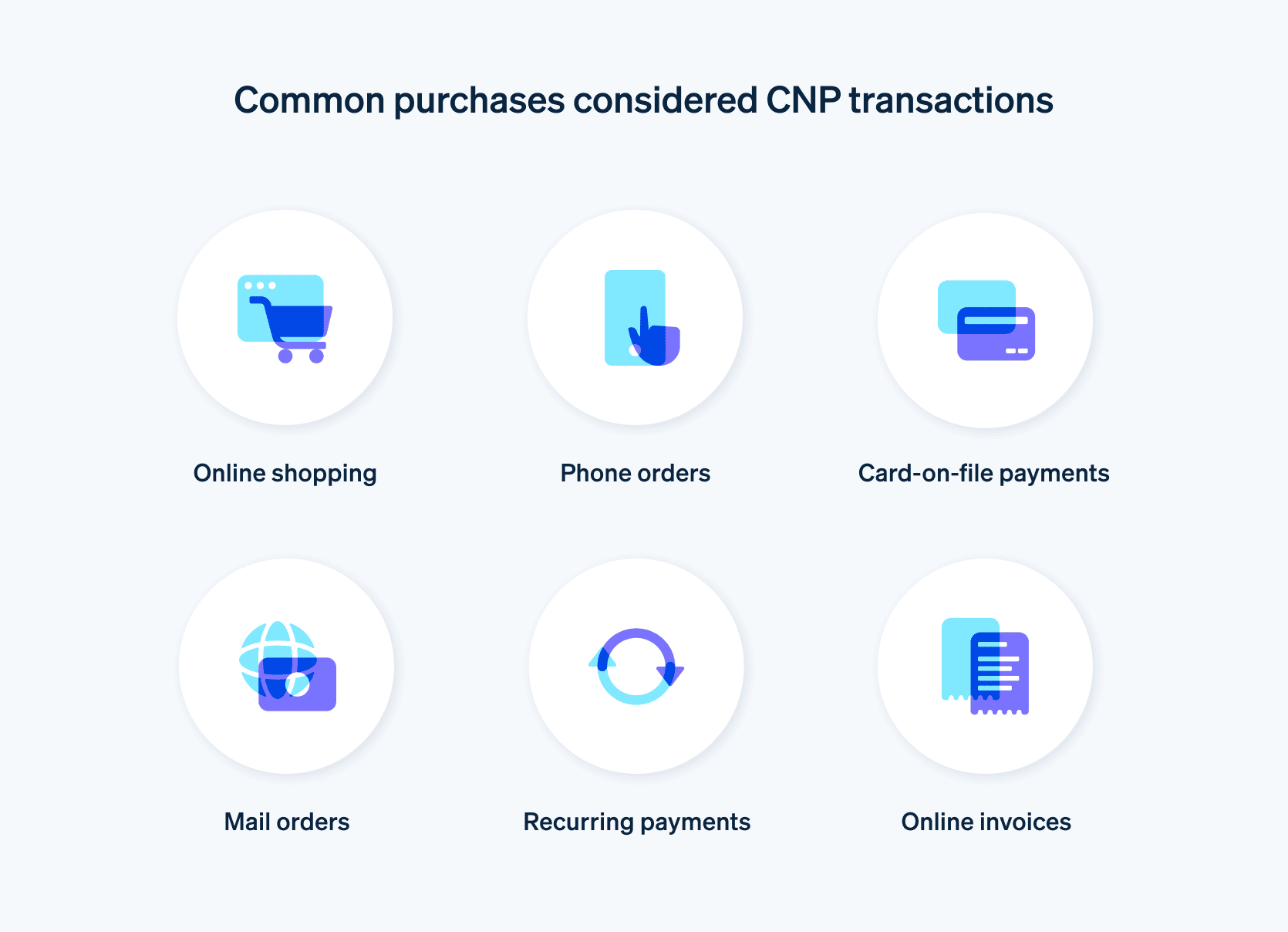无卡 (CNP) 交易是远程购买,无需通过读卡器或终端处理实体卡(也无需手动输入 PIN)。作为一种日益流行的购买方式,CNP 交易在 2021 年增长了 23%,因此线上销售的企业了解如何安全地接受它们非常重要。
我们将介绍不同类型的 CNP 交易,为什么它们可能存在欺诈风险,以及如何安全地接受它们。
目录
- 什么是 CNP 交易?
- 为什么 CNP 交易存在欺诈风险
- 如何安全地接受 CNP 交易:
- 线上
- 通过电话
- 线下和手动
- 线上
- CNP 交易手续费用和成本
什么是 CNP 交易?
要被视为 CNP 交易,付款时信用卡和持卡人都不能在场。
许多常见的购买被视为 CNP 交易,包括:
网上购物:客户通过网站或支付链接输入其银行卡详细信息和账单地址来购买商品或服务。订单可以运送到客户选择的地址或在店内取货。
电话订购:客户通过电话向处理收款的销售人员提供他们的银行卡详细信息和账单信息进行购买。
存档卡付款:客户使用他们之前提交给企业并已批准供将来使用的支付方式支付购买费用。
邮购:客户通过邮件购买商品或服务,方法是在实体订单上填写他们的账单信息并将其发送给企业。过去,客户通过商店目录进行邮购。
经常性付款:这些是按照约定的时间间隔从客户的信用卡或银行账户中扣除的自动付款,用于购买作为订阅一部分的商品和服务。当客户进行首次付款时,他们的账单信息将存储在企业的系统中,并用于后续的每笔付款。
在线发票:客户使用在线支付系统支付企业的发票。可以使用存储的或新的支付方式(包括信用卡和借记卡、银行转账和数字钱包)支付这些发票。

为什么 CNP 交易存在欺诈风险
由于 CNP 交易是在客户(或信用卡)未亲自到场进行验证的情况下处理的,这就让欺诈者有了可乘之机。当持卡人的账单信息被未经授权的个人泄露并获取时,就会发生 CNP 欺诈。实施欺诈的人窃取持卡人的支付凭证,例如卡号、CVC/CVV 代码和到期日期,并使用这些信息进行购买。
CNP 欺诈不仅会影响客户,还会导致企业损失收入,因为欺诈性收费通常会导致拒付。当客户发现他们的卡上有欺诈性交易时,他们可能会选择就付款向发卡行提出异议并要求退款。这意味着企业不仅损失了销售价值,还为诈骗分子提供了免费的产品或服务。如果企业发生过多的拒付,他们可能还需要支付费用。对于银行卡欺诈风险较高的企业,Stripe 提供额外的拒付保护。
如何安全地接受 CNP 交易
由于 CNP 欺诈会导致许多问题,因此企业必须尽可能构建最安全的支付流程。
以下是针对不同支付方式避免 CNP 欺诈的不同方法:
线上
在您的在线结账页面上,尽可能准确地捕获客户信息,例如卡类型、账号、到期日期和 CVC。要求提供其他信息有助于确保客户拥有实体卡,这意味着他们更有可能是合法持卡人。这还有助于建立地址验证系统 (AVS),该系统要求您的客户在交易过程中验证他们的账单地址和邮政编码(因为大多数诈骗分子无法获得此信息)。
面向欺诈团队的 Radar 是一套与 Stripe 集成的工具,是帮助企业主正面应对欺诈的强大选择。该平台的机器学习系统会分析来自客户交易的大量数据(例如地理定位的 IP 地址和结账时间),以深入了解潜在的欺诈用户。您可以结合使用您自己的欺诈数据和 Stripe 的行为信息来设置标准列表,以阻止可疑交易并执行人工审核。通过自己批准这些经过过滤的交易,您可以更好地检测和阻止欺诈活动。
Stripe 的结账页面 使您能够在交易过程中捕获所有必要的账单信息。由于地址查询、实时卡验证和信用卡发卡机构识别等智能功能,它显著加快并简化了客户的结账流程。
规则 是另一项有助于打击欺诈的 Radar 功能。借助该功能,您可以根据自己的条件设置过滤器,以便自动阻止满足特定高风险条件(例如,付款来自欺诈性收款频繁的地理位置)的付款。
通过电话
如果您通过电话接受订单,请确保从客户处收到的信息符合 PCI 要求。如果您是 Stripe 客户,则可以通过仪表板手动输入通过电话收到的收款信息。
线下和手动
对于线下交易,企业可以实施额外的身份验证,以降低欺诈风险,例如要求提供带照片的身份证件。企业主还应该使用加密服务来保护所有存储的银行卡数据。
CNP 交易手续费和成本
虽然企业对每笔成功的信用卡交易都会收取费用,但 CNP 手续费通常高于实体卡交易,因为它们会带来额外的风险。费用因行业和支付处理商的加价而异。一般来说,费用和成本遵循以下公式:
交易百分比 + 每笔交易的固定成本
对于美国的 Stripe 客户,费率为每笔成功的银行卡扣款 2.9% + 30¢。阅读我们的定价指南,了解您所在市场的费用和包含的功能。
本文中的内容仅供一般信息和教育目的,不应被解释为法律或税务建议。Stripe 不保证或担保文章中信息的准确性、完整性、充分性或时效性。您应该寻求在您的司法管辖区获得执业许可的合格律师或会计师的建议,以就您的特定情况提供建议。